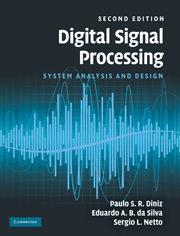Book contents
- Frontmatter
- Contents
- Preface
- Introduction
- 1 Discrete-time signals and systems
- 2 The z and Fourier transforms
- 3 Discrete transforms
- 4 Digital filters
- 5 FIR filter approximations
- 6 IIR filter approximations
- 7 Spectral estimation
- 8 Multirate systems
- 9 Filter banks
- 10 Wavelet transforms
- 11 Finite-precision digital signal processing
- 12 Efficient FIR structures
- 13 Efficient IIR structures
- References
- Index
11 - Finite-precision digital signal processing
Published online by Cambridge University Press: 05 June 2012
- Frontmatter
- Contents
- Preface
- Introduction
- 1 Discrete-time signals and systems
- 2 The z and Fourier transforms
- 3 Discrete transforms
- 4 Digital filters
- 5 FIR filter approximations
- 6 IIR filter approximations
- 7 Spectral estimation
- 8 Multirate systems
- 9 Filter banks
- 10 Wavelet transforms
- 11 Finite-precision digital signal processing
- 12 Efficient FIR structures
- 13 Efficient IIR structures
- References
- Index
Summary
Introduction
This chapter starts by addressing some implementation methods for digital filtering algorithms and structures. The implementation of any building block of digital signal processing can be performed using a software routine on a simple personal computer. In this case, the designer's main concern becomes the description of the desired filter as an efficient algorithm that can be easily converted into a piece of software. In such cases, the hardware concerns tend to be noncritical, except for some details such as memory size, processing speed, and data input/output.
Another implementation strategy is based on specific hardware, especially suitable for the application at hand. In such cases, the system architecture must be designed within the speed constraints at a minimal cost. This form of implementation is mainly justified in applications that require high processing speed or in large-scale production. The four main forms of appropriate hardware for implementing a given system are:
The development of a specific architecture using basic commercial electronic components and integrated circuits (Jackson et al., 1968; Peled & Liu, 1974, 1985; Freeny, 1975; Rabiner & Gold, 1975;Wanhammar, 1981).
The use of programmable logic devices (PLDs), such as field-programmable gate arrays (FPGAs), which represent an intermediate integrated stage between discrete hardware and full-custom integrated circuits or digital signal processors (DSPs) (Skahill, 1996).
The design of a dedicated integrated circuit for the application at hand using computer-automated tools for a very large scale integration (VLSI) design.
[…]
- Type
- Chapter
- Information
- Digital Signal ProcessingSystem Analysis and Design, pp. 668 - 739Publisher: Cambridge University PressPrint publication year: 2010

